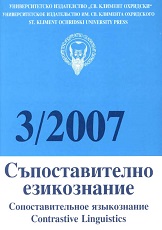Прозодична структура на ранните детски изказвания
Prosodic structure of early childhood utterances
Author(s): Julijana StojanovaSubject(s): Language studies, Language and Literature Studies, Theoretical Linguistics, Applied Linguistics, Lexis, Cognitive linguistics, South Slavic Languages
Published by: Софийски университет »Св. Климент Охридски«
Keywords: Prosodic structure; early childhood utterances;
Summary/Abstract: This paper describes some universal and language specific (Bulgarian) characteristics of the prosodic words at the one-word stage of language development. Central to this description are the notions of a prosodic word as well as of a minimal word constraint, the latter expressing the tendency in many languages for the lexical words to be composed of at least one binary foot. The Bulgarian data (stemming from five longitudinally studied subjects aged between 1;2 and 2;2 years) conform to the universal tendency according to which, at this early stage of language development, the minimal word is also the maximal one. Besides, the Bulgarian sample shows that children are sensitive to the language specific prosodic structure of the input: the analyzed one-word verbal production reflects the dominance of trochaic over iambic feet, the relatively great deal of bimoraic feet, and the marginal character of the subminimal words that are typical of Bulgarian (in contrast to French, for example). The combined influence of the above mentioned universal and language specific factors gives a convincing explanation of the phenomena of consonant and syllable truncation in children’s early speech.
Journal: Съпоставително езикознание / Сопоставительное языкознание
- Issue Year: 2007
- Issue No: 3
- Page Range: 65-80
- Page Count: 16
- Language: Bulgarian
- Content File-PDF

